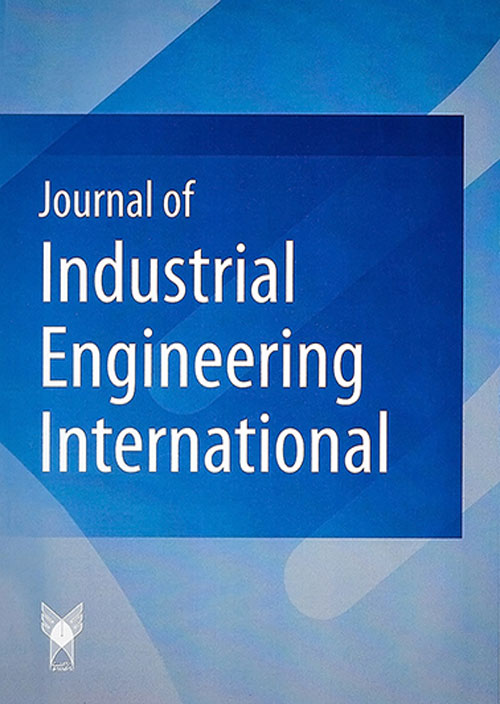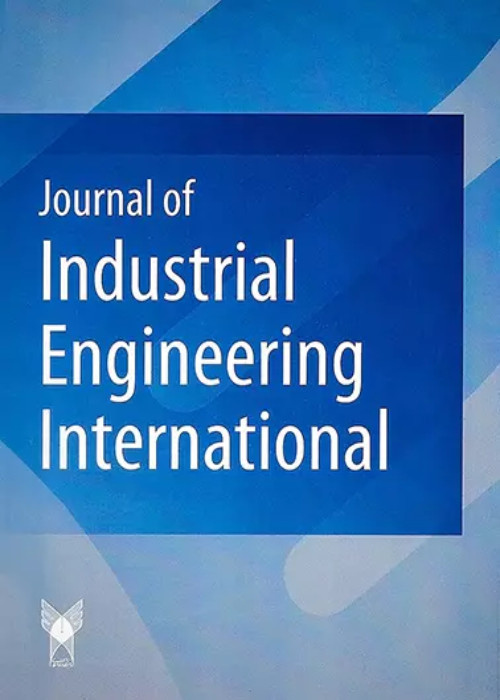فهرست مطالب

Journal Of Industrial Engineering International
Volume:13 Issue: 4, Autumn 2017
- تاریخ انتشار: 1396/09/10
- تعداد عناوین: 9
-
-
Pages 417-426
Many hierarchical techniques to solve large Markov decision processes (MDPs) are based on the partition of the state space into strongly connected components (SCCs) that can be classified into some levels. In each level, smaller problems named restricted MDPs are solved, and then these partial solutions are combined to obtain the global solution. In this paper, we first propose a novel algorithm, which is a variant of Tarjan’s algorithm that simultaneously finds the SCCs and their belonging levels. Second, a new definition of the restricted MDPs is presented to ameliorate some hierarchical solutions in discounted MDPs using value iteration (VI) algorithm based on a list of state-action successors. Finally, a robotic motion-planning example and the experiment results are presented to illustrate the benefit of the proposed decomposition algorithms.
Keywords: Markov decision process, Graph theory, Tarjan’s algorithm, Strongly connected components, Decomposition -
Pages 427-443
In this paper we develop an economic order quantity model to investigate the optimal replenishment policies for instantaneous deteriorating items under inflation and trade credit. Demand rate is a linear function of selling price and decreases negative exponentially with time over a finite planning horizon. Shortages are allowed and partially backlogged. Under these conditions, we model the retailer’s inventory system as a profit maximization problem to determine the optimal selling price, optimal order quantity and optimal replenishment time. An easy-to-use algorithm is developed to determine the optimal replenishment policies for the retailer. We also provide optimal present value of profit when shortages are completely backlogged as a special case. Numerical examples are presented to illustrate the algorithm provided to obtain optimal profit. And we also obtain managerial implications from numerical examples to substantiate our model. The results show that there is an improvement in total profit from complete backlogging rather than the items being partially backlogged.
Keywords: Inventory, Deterioration, Trade credit, Backlogging, Inflation, Time value of money, Finite planning -
Pages 445-453
The hub location problem arises in a variety of domains such as transportation and telecommunication systems. In many real-world situations, hub facilities are subject to disruption. This paper deals with the multiple allocation hub location problem in the presence of facilities failure. To model the problem, a two-stage stochastic formulation is developed. In the proposed model, the number of scenarios grows exponentially with the number of facilities. To alleviate this issue, two approaches are applied simultaneously. The first approach is to apply sample average approximation to approximate the two stochastic problem via sampling. Then, by applying the multiple cuts Benders decomposition approach, computational performance is enhanced. Numerical studies show the effective performance of the SAA in terms of optimality gap for small problem instances with numerous scenarios. Moreover, performance of multi-cut Benders decomposition is assessed through comparison with the classic version and the computational results reveal the superiority of the multi-cut approach regarding the computational time and number of iterations.
Keywords: Reliable hub location problem, Two-stage stochastic programming, Sample average approximation, Multiple cuts Benders decomposition -
Pages 455-463
In this paper, an economic order quantity (EOQ) inventory model for a deteriorating item is developed with the following characteristics:(i)The demand rate is deterministic and two-staged, i.e., it is constant in first part of the cycle and linear function of time in the second part.(ii)Deterioration rate is time-proportional.(iii)Shortages are not allowed to occur.The optimal cycle time and the optimal order quantity have been derived by minimizing the total average cost. A simple solution procedure is provided to illustrate the proposed model. The article concludes with a numerical example and sensitivity analysis of various parameters as illustrations of the theoretical results.
Keywords: Constant, time -dependent linear demand rate, Deteriorating items, EOQ, Time-proportional deterioration rate -
Pages 465-478
Models that aim to optimize the design of supply chain networks have gained more interest in the supply chain literature. Mixed-integer linear programming and discrete-event simulation are widely used for such an optimization problem. We present a hybrid approach to support decisions for supply chain network design using a combination of analytical and discrete-event simulation models. The proposed approach is based on iterative procedures until the difference between subsequent solutions satisfies the pre-determined termination criteria. The effectiveness of proposed approach is illustrated by an example, which shows closer to optimal results with much faster solving time than the results obtained from the conventional simulation-based optimization model. The efficacy of this proposed hybrid approach is promising and can be applied as a powerful tool in designing a real supply chain network. It also provides the possibility to model and solve more realistic problems, which incorporate dynamism and uncertainty.
Keywords: Hybrid optimization, Supply chain network design, MILP . Simulation -based optimization, Uncertainty -
Pages 479-486
Several studies on photovoltaic systems focused on how it operates and energy required in operating it. Little attention is paid on its configurations, modeling of mean time to system failure, availability, cost benefit and comparisons of parallel and series–parallel designs. In this research work, four system configurations were studied. Configuration I consists of two sub-components arranged in parallel with 24 V each, configuration II consists of four sub-components arranged logically in parallel with 12 V each, configuration III consists of four sub-components arranged in series–parallel with 8 V each, and configuration IV has six sub-components with 6 V each arranged in series–parallel. Comparative analysis was made using Chapman Kolmogorov’s method. The derivation for explicit expression of mean time to system failure, steady state availability and cost benefit analysis were performed, based on the comparison. Ranking method was used to determine the optimal configuration of the systems. The results of analytical and numerical solutions of system availability and mean time to system failure were determined and it was found that configuration I is the optimal configuration.
Keywords: Reliability, Solar panel, Availability-Photovoltaic -
Pages 487-497
In every production plant, it is necessary to have an estimation of production level. Sometimes there are many parameters affective in this estimation. In this paper, it tried to find an appropriate estimation of production level for an industrial factory called Barez in an uncertain environment. We have considered a part of production line, which has different production time for different kind of products, which means both environmental and system uncertainty. To solve the problem we have simulated the line and because of the uncertainty in the times, fuzzy simulation is considered. Required fuzzy numbers are estimated by the use of bootstrap technique. The results are used in production planning process by factory experts and have had satisfying consequences. Opinions of these experts about the efficiency of using this methodology, has been attached.
Keywords: Production planning, Fuzzy simulation, Bootstrap technique, Discrete event simulation -
Pages 499-512
Recently, much emphasis has given to study the control and maintenance of production inventories of the deteriorating items. Rework is one of the main issues in reverse logistic and green supply chain, since it can reduce production cost and the environmental problem. Many researchers have focused on developing rework model, but few of them have developed model for deteriorating items. Due to this fact, we take up productivity and rework with deterioration as the major concern in this paper. In this paper, a production-inventory model with deteriorative items in which one cycle has n production setups and one rework setup (n, 1) policy is considered for deteriorating items with stock-dependent demand in case 1 and exponential demand in case 2. An effective iterative solution procedure is developed to achieve optimal time, so that the total cost of the system is minimized. Numerical and sensitivity analyses are discussed to examine the outcome of the proposed solution procedure presented in this research.
Keywords: Inventory, Rework, Production, Time dependent demand -
Pages 513-520
Teamwork contributes to a considerable improvement in quality and quantity of the ultimate outcome. Collaboration and alliance between team members bring a substantial progress for any business. However, it is imperative to acquire an appropriate team since many factors must be considered in this regard. Team size may represent the effectiveness of a team and it is of paramount importance to determine what the ideal team size exactly should be. In addition, information technology increasingly plays a differentiating role in productivity and adopting appropriate information sharing systems may contribute to improvement in efficiency especially in competitive markets when there are numerous producers that compete with each other. The significance of transmitting information to individuals is inevitable to assure an improvement in team performance. In this paper, a model of teamwork and its organizational structure are presented. Furthermore, a mathematical model is proposed in order to characterize a group of sub-teams according to two criteria: team size and information technology. The effect of information technology on performance of team and sub-teams as well as optimum size of those team and sub-teams from a productivity perspective are studied. Moreover, a quantitative sensitivity analysis is presented in order to analyze the interaction between these two factors through a sharing system.
Keywords: Teamwork, Team size, Sub, team, Information technology, Information sharing system, Productivity


